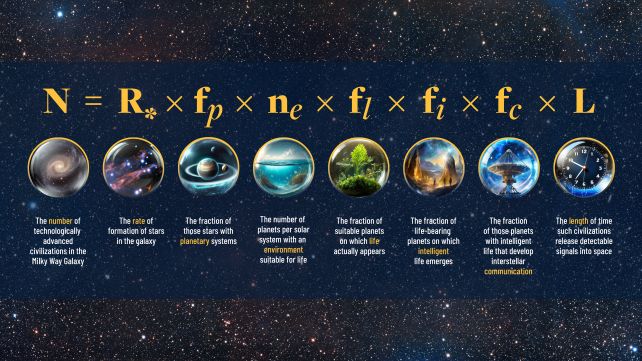One of the biggest existential mysteries – and the most difficult to answer – is whether Earth is all alone in this Universe in bearing a solitary candle of intelligent life in the darkness.
Based on what we have observed, it seems like we're unique. But there are a number of possible reasons why we haven't detected the light of alien civilization elsewhere in the Milky Way, and a number of factors that could be influencing whether or not it emerges.
A little over half a century ago, these variables were assembled into a tool known as the Drake Equation, allowing scientists to fiddle and ponder.
But one variable has been missing from the Drake Equation, which a team led by physicist Daniele Sorini of Durham University in the UK has included as the basis of a new calculation: the effect of dark energy on the rate of star formation in the Universe.
"Understanding dark energy and the impact on our Universe is one of the biggest challenges in cosmology and fundamental physics," Sorini explains. "The parameters that govern our Universe, including the density of dark energy, could explain our own existence."

Dark energy is an unidentified force that causes the expansion of the Universe to accelerate. Although we don't know what it is made of, we are able to tell how much of it there is: roughly 71.4 percent of the matter-energy content of the Universe is dark energy.
Another 24 percent is dark matter; only the remaining 4.6 percent is normal baryonic matter, the stuff from which all stars, planets, black holes, dust, humans, and everything else we can theoretically see and touch is made.
One of our assumptions about life is that it requires a star. It may not, but possibility of life emerging on a body far from a blazing source of energy is so remote as to be unhelpful in the case of the Drake Equation.
So, assuming that a star is required for life, knowing the rate of star formation in a universe like ours could tell us something about the chances of finding life within it.
Stars form from clouds of dust and gas that collapse into dense clumps, which in turn accumulate so much mass the density and heat in their cores kickstarts nuclear fusion. The outward pull of dark energy plays a role in the rate at which it can occur. It counters the inward pull of gravity that may otherwise see all the matter in the Universe condense in clumps too dense for star formation.
The researchers calculated this matter conversion rate for different dark energy densities in a model Universe to determine the most efficient rate at which stars can form. And they found that the most efficient rate is when 27 percent of the matter in the Universe is being converted into stars.

What makes this interesting is that this is not the Universe we live in. Our Universe has a conversion rate of 23 percent. It's not the first time we've found evidence that humanity did not emerge in the most optimum conditions for life, which potentially raises the chances that intelligent life could have emerged elsewhere in the Universe.
"Surprisingly," Sorini says, "we found that even a significantly higher dark energy density would still be compatible with life, suggesting we may not live in the most likely of universes."
There are many other factors that may influence the chances of intelligent life emerging. The rate of star formation is just one. Others include the number of those stars that have planets; and the number of those planets that have habitable conditions. Then there are the variables we don't know, like how the building blocks of life are delivered and come together into an evolving system.
But each piece of research contributes insights that may, one day, allow us to see a bigger picture than the one we see now. This, in turn, will help us narrow down how and where to look for other civilizations that may be scattered throughout our galaxy.
"It will be exciting," says theoretical physicist Lucas Lombriser of the University of Geneva in Switzerland, "to employ the model to explore the emergence of life across different universes and see whether some fundamental questions we ask ourselves about our own Universe must be reinterpreted."
The research has been published in The Monthly Notices of the Royal Astronomical Society.
